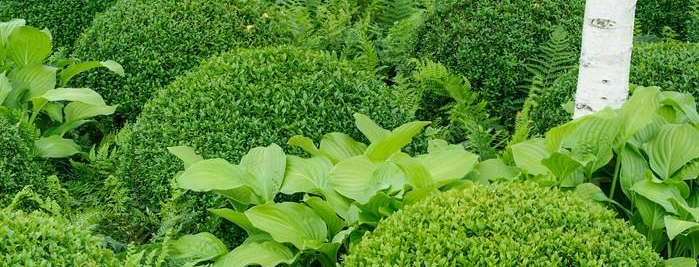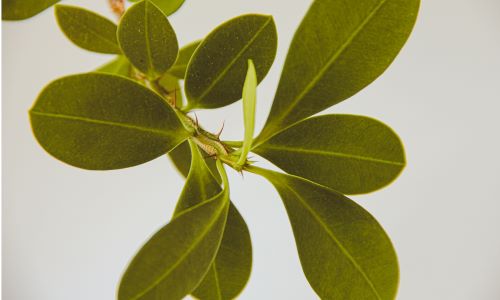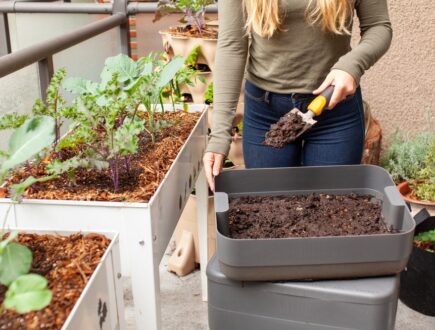Log in or create new account to save this product to your wishlist.

When to trim your box hedge — when, why & how!
Box plants are among the favourites of the hedge world because they're so versatile. But how and when to trim box hedges? Find out here.
🌱 All important maintenance moments for your lawn during the year. Leave your email and we will send you the lawn calendar for free.
Enter your email
Receive the lawn calendar in the mail
Enjoy a green lawn all year round!

- Order by 2PM = shipped today
- 250.000+ satisfied customers!
- 60 day satisfaction guarantee
Are you considering a bit of topiary? Do you gaze upon your neighbour’s excellently pruned or shaped box hedges with envy, wishing you had the skill and confidence to shape your hedge without damaging the plant? And when to trim box hedge – that eternal dilemma!
- What is a box plant?
- The needs of the box plant
- Types of box hedge
- Cutting a box plant — more than just art?
- Topiary vs Trimming — when to cut box plants
- The correct pruning tools for box plants!
- A step-by-step guide to guide to topiary cutting
- Box plant pruning aftercare
- Dispose of box plant cuttings wisely!
- Common mistakes to avoid when trimming box hedges
- FAQs
Box hedges are stunning evergreens that you can carve into interesting shapes. But if you prune incorrectly, you can damage the plant! So, to ensure that the plant continues to grow densely and vigorously, you need some expert tips.
And that’s what you’ll get if you read this article — all about how and when to trim box hedges. We’ll explore how to cut using the right tools, including a step-by-step guide to box hedge cutting.
So, let’s get started, shall we?
What is a box plant?

A box plant is an evergreen bush that belongs to the Buxaceae family. It’s popular in gardens across the planet due to its dense branch networks, small, leathery leaves, and ability to hold shape for a decent time period.
Box hedges are probably one of the more satisfying hedges to trim and carve, giving your garden a noble touch with bushes cut into a range of shapes, including:
- Spheres
- Pyramids
- Boxes
- Animals
- Machines
In fact, it’s possible to transform a box hedge into literally any shape — your imagination is literally the limit!
The needs of the box plant

Box plants are hardy and versatile — happy in sandy, well-drained clay soil and full sun or partial shade.
The plant’s slow growth makes it a boon for those of us who would rather not spend every couple of months pruning and a bonus for the more creative among us who enjoy nothing more than shaping our box hedges into interesting shapes.
Types of box hedge
There are several Buxaceae varieties, including:
- Common box plant (Buxus sempervirens)
- Small-leaved box plant (Buxus microphylla)
- Japanese box plant (Buxus japonica)
Cutting a box plant — more than just art?
Regular pruning keeps your box plant healthy and in good shape. But there are several reasons why pruning your buxus is an essential garden task:
- Maintains the desired shape and design
- Removes old, dead, and potentially diseased wood from the plant
- Better air circulation minimises the potential for pests and diseases
- Prevents the plant from growing too big
Topiary vs Trimming — when to cut box plants

There’s a clear distinction between an annual trim and a shaping:
Topiary
Topiary is the art of shaping plants into interesting and fantastical shapes. This means you’ll cut some areas deeply while trimming others minutely. For best results, you should prune twice a year.
Spring pruning
Complete the spring pruning before growth starts for the year once the threat of frost has passed. This pruning helps rid the plant of dead and damaged wood and foliage, which is excellent preparation for shaping.
This is an excellent time to check your plant’s condition after the winter. You may need to fertilise the plant after pruning, especially if the leaves are looking a little weak and pale.
Late summer/autumn pruning
Your box plant’s principal growth period is over by the end of August/September, so this is a good time for reshaping, which helps regulate over-winter growth. The second pruning prepares the plant for the change in the weather, setting it up to bear the wet and frosty winter months.
Of course, you can never quite rely on the UK’s weather, and there’s as likely to be a mini-heatwave in October as rain in July! So, avoid hot weather or direct sunlight for pruning, which can burn and stress the plant.
A cool, cloudy day is ideal. Or what for the late afternoon if there are unseasonally high temperatures?
Trimming
While box plants grow relatively slowly, you may need to trim every four weeks to maintain complex shapes.
However, make sure these interim trims are trims — not scalpings! Over-pruning will weaken the plant, making it susceptible to pests and disease.
Do you have other hedges or plants in your garden ready for a trim? Check out our expert pruning articles.
The correct pruning tools for box plants!
You’ll get the best results when using the right tools.
So, I recommend using the following:
- Secateurs — ideal for trimming thinner branches, long shoots, and making precise cuts for topiary.
- Hedge trimmer — perfect for more extreme shaping
- Hand saw — offering the safest way to remove thick or hard branches
- Gloves — to protect your hands against sharp branches, which can easily cut your hands
But, perhaps, the most important tool of them all for the expert topiarist is the sharpening tool. Never use blunt tools to cut into your plants — the blunt edge tears the plant rather than slices, leaving a larger wound, which is much more prone to infection.
Use a tool, such as a grindstone, to sharpen the blades of your cutting tools, and remember to clean the blades thoroughly before and after each pruning.
A step-by-step guide to guide to topiary cutting
These steps will help ensure an outstanding result that won’t stress the plant:
- Sharpen, clean, and dry your tools, especially the cutting tools.
- Spread a tarp underneath the plants, around the base, to catch the cuttings. It makes it easier to tidy up afterwards.
- Thin out the dead, diseased, thin, and weak branches down to the next healthy shoot or stem.
- Remove unwanted thick branches.
- Use string or a folding rule as a stencil for your desired shape. And cut gradually, avoiding big cuts when shaping the plant. Remember, you can always cut shorter — you can’t elongate a short branch!
- Go slow, and keep standing back to assess your work as you go. Don’t be tempted to over-cut — be conservative with each cut — standing back to take in the bigger picture.
- Remove the tarp and collect any excess waste.
- Fertilise and water the plant. Give it plenty of water (but avoid waterlogging the soil). Box plants like well-drained soil.
Box plant pruning aftercare

Keeping your plant healthy is the best way to help maintain its growth and shape. So, follow these aftercare tips for excellently healthy box plants:
- Water regularly, especially after trimming and cutting.
- Ensure the soil drains well. If you have clay soil, you may need to dig in a soil improver to help prevent root rot and water-logging.
- Fertilise with a good quality product at least once a year — twice ideally. Use a slow-release formula to prevent shocking the roots.
- Add 5-10cm of mulch around the plant’s base. This reduces weeds and protects the roots from extreme temperatures.
- Check for pests and diseases regularly. Common culprits are box plant border, fungal infections, and powdery mildew.
Dispose of box plant cuttings wisely!
Box plant cuttings are poisonous, so use local council green bins to dispose of the cuttings. Chop the waste into small sections, and mix it with other organic waste, such as leaves, garden, and kitchen waste.
However, you can also compost box cuttings — but don’t use the compost on fruit and vegetable beds.
Common mistakes to avoid when trimming box hedges
Box plants are relatively straightforward plants to maintain. However, there are some common mistakes to avoid, which can affect the plant’s vitality. These include:
Excessive pruning — this causes stress and stunts your plant’s growth. Make regular, light cuts every four weeks to maintain your desired shape.
Pruning in hot temperatures — this causes burns on cut sites and puts the plant under stress. Choose a slightly cloud, cool day instead.
Use dirty or blunt tools — if you want to infect your plant with diseases, use dirty tools. Always use clean, sharp cutting tools to maintain the plant’s health, ensuring a precise, small cut.
Pruning at the wrong time — avoid pruning during the winter, when the plant is dormant.
FAQs
Always use clean, sharp tools, and make minor cuts — always standing back after each cut to assess progress. Avoid extreme cuts, as box plants grow slowly, and it will take up to a year or more for ill-judged cuts to re-grown.
This isn’t recommended. Cutting a box plant too harshly results in shock, which weakens the plant, making it susceptible to diseases (and pests). Trim gradually, leaving at least four weeks in between each cutting.
Never prune in high temperatures or full sun. This will dry out the plant. Choose a cloudy day when the temperature is cooler for excellent results every time.
Ready to get started?
I hope I’ve provided all the information you’ll need for successful box plant pruning. But if you have questions, don’t hesitate to email us.
Alternatively, check out our comprehensive Help & Advice section, offering expert tips on everything lawn and garden orientated.
Thanks for reading!
-
How to Grow Eucalyptus in British GardensWith a little love and care, eucalyptus trees can thrive in English gardens. Since they don’t germinate well without proper help, there are not considered invasive. So, there is no reason not to plant them if you enjoy their looks.Read more
-
Transform Your Garden with All-Year-Round Flowering PlantsDid you know you can enjoy blooming flowers even in January? With the right selection of all year round plants, there’s no need to wait until spring to add some colour to your garden.Read more
-
How to Create a Butterfly Garden: A Simple Guide for British GardensThe UK's butterfly population includes 59 different species. These beautiful winged creatures face a steady decline because of habitat loss, pollution and changing weather patterns. Your garden can become a vital link between nature reserves and natural habitats. Let’s explore how.Read more
-
Volcanic Rock Dust for Your Garden—Application and TipsDid you know that volcanic rock dust is a brilliant organic soil improver? This article explains exactly what it's good for and how to use it properly.Read more
-
How to Use Landscape Fabric ProperlyIf weeds or erosion in your garden are troubling you, landscape fabric might be the solution. We’ll explain how and when to use it properly, just keep on reading.Read more
-
Hostas: A Complete Care GuideIf you have a north-facing garden or some shady corners on your property, hostas are the plants for you. These green delights thrive particularly well in partial to full shade and require consistently moist soil to perform at their best.Read more
-
How to Grow Grapes in Your Garden: A Simple Step-by-Step GuideGrapevines produce some tasty fruits, but often they are simply grown for their gorgeous leaves. Whatever your motivation may be, we have a guide on how to grow grapes for you.Read more
-
Worm Composting Made Simple: From Kitchen Scraps to Garden GoldDid you know that a single pound of composting worms can devour half their body weight in waste every day? That's roughly twelve pounds of kitchen scraps transformed into garden gold each month! We will look at how to make this happen.Read more
Leave a comment
Your answer will be displayed on the site and the interested party will be notified by email.
Leave a comment
Have a question or want to share your experience? Leave us a comment.

- Order by 2PM = shipped today
- 250.000+ satisfied customers!
- 60 day satisfaction guarantee

- Order by 2PM = shipped today
- 250.000+ satisfied customers!
- 60 day satisfaction guarantee

- Order by 2PM = shipped today
- 250.000+ satisfied customers!
- 60 day satisfaction guarantee

🌱 All important maintenance moments for your lawn during the year. Leave your email and we will send you the lawn calendar for free.
Enter your email
Receive the lawn calendar in the mail
Enjoy a green lawn all year round!





















Comments (0)
There are no comments yet. Well then, what are you waiting for to
Be the first to write your comment!inaugurate this pretty page?
Do you have some comments?